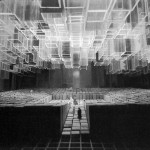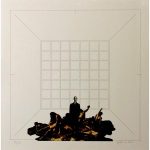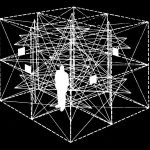Giulio Camillo Delminio (1480-1544) was an Italian Renaissance polymath. His most famous project, started in ca.1519 and carried on until his death, was “The Theatre of Memory,” an ideal architectural structure destined to “
Camillo imagined the theater as a wooden structure formally based on the Vitruvian description of the Roman theater from the De Architectura. However, he reversed the canonical relationship between audience and stage, because he conceived the theatre for a single spectator located on the stage.

The theater is divided into seven cloves and is structured on seven levels of steps defining forty-nine areas, each one associated with a symbolic figure from mythology, from the Cabal or from hermeticism.
All human knowledge would have been archived on the different levels of the half-circle, referring to a projection of the human mind and could have been retrieved through mental associations with images and symbols. Giulio Camillo described his theatre as a mens fenestrata, a “mind endowed with windows”, a structure providing the possibility of looking inside the human mind. He also defined it as a
The whole configuration of the Theatre of Memory imply symbolic meanings. The structure itself lies on seven pillars, which refer to those bearing Solomon’s House of Wisdom.
Each one of the seven cloves is characterized on the lower level by an image referred to

The theatre itself refers to mnemonic techniques called “The art of memory,” a series of methods allowing better memorization of information through the association of mental places to information, or, through the spatialization of memory into ideal places. Giulio Camillo takes it a further step by imagining an actual materialization of human memory and extending it to collective knowledge, making the theatre a sort of ancestor of the encyclopedia or even of the Internet.
For a long time, Camillo looked for a patron capable of carrying out his project and physically building his wooden theatre. Probably, only a wooden model was finally realized, as testified by a letter from Viglius van Aytta, an emissary of Erasmus of Rotterdam.
English historian Frances Yates wrote a long and detailed description and interpretation of the Theatre of Memory in her famous book The art of memory published in 1966. More recently, other historians of Medieval and Renaissance art and literature have renewed the interest on the subject of Camillo and the Art of Memory.
Among them: Paolo Rossi, Clavis universalis. Arti della memoria e logica combinatoria da Lullo a Leibniz, Milano—Napoli, Ricciardi, 1960.
Mary Carruthers, The Book of Memory. A Study of Memory in Medieval Culture, Cambridge, Cambridge University Press, 1990.
Lina Bolzoni, La stanza della memoria. Modelli letterari e iconografici nell’età della stampa, Torino, Einaudi, 1995.
Lina Bolzoni (ed.), Giulio Camillo, L’idea del theatro con «L’idea dell’eloquenza», il «De transmutatione» e altri testi inediti a cura di Lina Bolzoni, Adelphi, 2015.










Leave a Reply